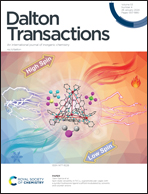A copper-containing analog of the biomineral whitlockite: dissolution–precipitation synthesis, structural and biological properties†
Abstract
In the present work, copper whitlockite (Cu-WH, Ca18Cu2(HPO4)2(PO4)12) was successfully synthesized and comprehensively characterized, founding the base knowledge for its future studies in medicine, particularly for bone regeneration. This material is a copper-containing analog of the well-known biomineral magnesium whitlockite (Mg-WH, Ca18Mg2(HPO4)2(PO4)12). The synthesis of powders was performed by a dissolution–precipitation method in an aqueous medium under hydrothermal conditions. Phase conversion from brushite (CaHPO4·2H2O) to Cu-WH took place in an acidic medium in the presence of Cu2+ ions. Optimization of the synthesis conditions in terms of medium pH, temperature, time, Ca/Cu molar ratio and concentration of starting materials was performed. The crystal structure of the synthesized products was confirmed by XRD, FTIR and Raman spectroscopy, 1H and 31P solid-state NMR, and EPR. Morphological features and elemental distribution of the synthesized powders were studied by means of SEM/EDX analysis. The ion release in SBF solution was estimated using ICP-OES. Cytotoxicity experiments were performed with MC3T3-E1 cells. The study on thermal stability revealed that the synthesized material is thermally unstable and gradually decomposes upon annealing to Cu-substituted β-Ca3(PO4)2 and Ca2P2O7.



 Please wait while we load your content...
Please wait while we load your content...